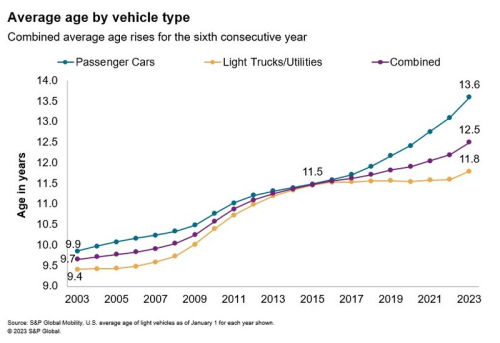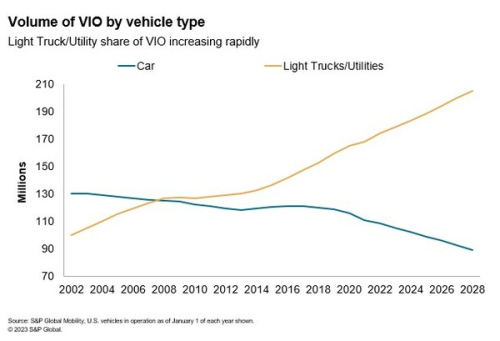
With more than 284 million vehicles in operation (VIO) on US roads, the average age of cars and light trucks in the US has risen again this year to a new record of 12.5 years, up by more than three months over 2022, according to the latest analysis from S&P Global Mobility.
The growth is in line with the firm's prediction from last year that constrained new vehicle sales would continue to impact and put upward pressure on the average age. In addition, the continued rise of light trucks/utilities means the number of passenger cars on the road will fall beneath 100 million for the first time since 1978.
This is the sixth straight year of increase in the average vehicle age of the US fleet. It also reflects the highest yearly increase since the 2008-2009 recession, which caused acceleration in average age beyond its traditional rate due to the sharp decline in new-vehicle sales demand.
In 2022, the average age experienced upward pressure initially due to supply constraints that caused low levels of new vehicle inventory, and then by slowing demand as interest rates and inflation reduced consumer demand in the second half of the year. The combined effect caused retail and fleet sales of new light vehicles in the US to drop 8% from 2021’s 14.6 million units to 13.9 million units in 2022, the lowest level recorded in over a decade.
Despite economic headwinds, new vehicle sales are projected to surpass 14.5 million units in 2023, according to S&P Global Mobility forecasts, which is expected to curb the rate of average age growth in the coming year.
The increased pace of growth of the average light vehicle age benefits the vehicle service industry. An older fleet means vehicles will continue to need repair work and service to perform correctly.
The aftermarket sector trajectory typically follows growth in average vehicle age, as consumers invest more to keep their aging vehicles running, barring some exceptions. As a result, the most recent S&P Global Channel Forecast conducted jointly with Auto Care Association and MEMA Aftermarket Suppliers, estimates revenues of the U.S. light duty aftermarket in 2022 have grown to $356.5 billion, up more than 8.5% over 2021, For this year, early indications from the same forecast estimate a potential revenue increase in 2023 of 5% or more, prior to adjustments for inflation and other factors. The newest Channel Forecast is set to be published in June.
According to S&P Global Mobility, the volumes of vehicles ages 6-14 will grow by another 10 million units by 2028, adding to an already favorable volume of vehicles in the aftermarket target range.
In total, vehicles older than six years will account for more than 74% of the vehicle fleet in 2028, according to S&P Global Mobility estimates. These vehicles drive the most repair opportunities, and should serve as a positive trend for the independent aftermarket.
New vehicle market skews further in favor of light trucks. Light truck/utility growth has trended upward for several years, and in 2022, 78% of all new vehicles registered in the US last year were in this category. Given the exponential growth of the sport-utility segment, vehicles in operation (VIO) has shifted as well—with light trucks/utilities representing nearly 63% of the population.

Strong consumer preference for light trucks over cars points to a growing business potential for the vehicle service industry, as light trucks/utilities generally cost more to maintain than cars, and people also tend to keep them longer. S&P Global Mobility analysis shows that within the next 18-24 months, the total volume of passenger cars—sedans, coupes, wagons, hatchbacks—on the road in the US could drop below 100 million for the first time since 1978. By 2028, S&P Global Mobility expects at least 70% of VIO in the US to be light trucks/utilities.
BEVs. The average age of battery electric vehicles (BEVs) in the US is 3.6 years this year, down from 3.7 years last year. The average age has been hovering between 3 and 4 years since 2017 and is largely compressed as the new BEV registrations continue to grow. According to S&P Global Mobility estimates, new BEV registrations achieved a 58% gain year over year, to nearly 758,000 units in 2022.
However, the average age of BEVs is under pressure as BEVs are leaving the fleet more rapidly than their ICE and diesel counterparts.
According to S&P Global Mobility analysis, of the nearly 2.3 million BEVs registered in the US from 2013 to 2022, about 2.12 million are still on the road today—about 6.6% have left the fleet. When it comes to other fuel types excluding BEVs, of the roughly 158 million sold in the same timeframe, are around 149.8 million vehicles on the road today—reflecting that 5.2% have left the fleet over the time frame.